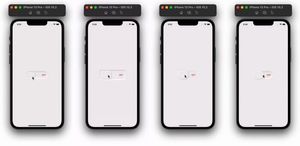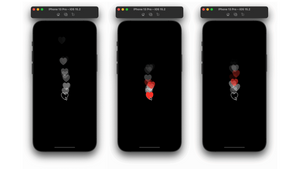今天,我們會客製由一個視圖控制器 (ViewController) 轉場到另一個的轉場動畫。
為什麼會想要寫這個主題呢?過去,我花了很多時間去了解視圖控制器之間的轉換。遺憾的是,目前線上鮮有能簡單說明視圖控制器動畫轉場的教程。
因此,我決定寫幾篇文章,教大家用最簡單的方法,創建令人驚艷的轉場動畫。而這篇文章會比前一篇更進階。
讓我們開始來創建客製化的 UINavigationController 轉場動畫吧!
先看一下我們最後的成果:
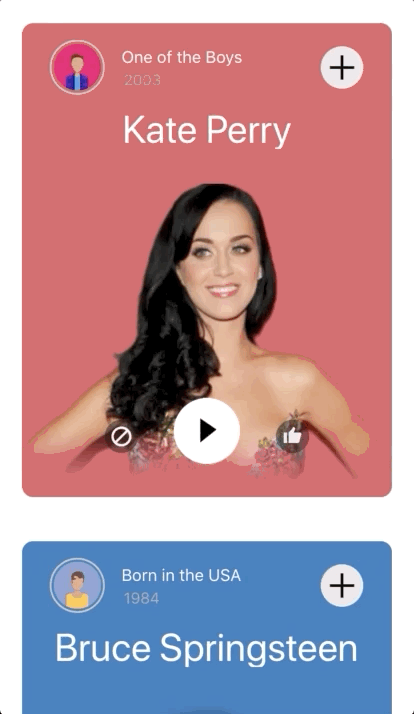
專案
讓我們先花點時間來了解這個專案和以下元素:
- MainViewController.swift:主視圖控制器,你會在這裡看到 fadeIN 或 fadeOut 單元格的方法。
- MainViewController+DataSource.swift:我們在這檔案放置 TableView DataSource 方法。
- MainViewController+ProtocolTransitions.swift:在這裡,我們可以看到要製作動畫的每個物件的協定 (Protocol)。
- PushedViewController.swift:專案中的第二個視圖控制器,它就是動畫的最終狀態。
- AnimationCollectionViewLayout.swift:這是用在 MainViewController CollectionView 的 CollectionView Layout。
- MainTableViewCell.swift:這是我們將在專案的 MainViewController 上使用的 MainTableViewCell。
- Helpers.swift:我們會在這裡定義在 MainViewController 和 PushedViewController 上使用的協定,以獲取要進行動畫處理的物件的引用。
- PushAnimator.swift: 此類別將繼承自 NSObject,並將實作 UIViewControllerAnimatedTransitioning 協定,以從 MainViewController 轉換到 PushedViewController。
- PopAnimator.swift: 此類別將繼承自 NSObject ,並將實作 UIViewControllerAnimatedTransitioning 協定,以從 PushedViewController 轉換到 MainViewController。
- TransitionCoordinator.swift: 此類別將繼承自 NSObject,並將實作 UINavigationControllerDelegate 協定。 在此類別中,我們定義 push 時使用 PushAnimator 的轉場,以及在 pop 時使用的 PopAnimator 轉場效果。
小提示 #2:當視圖控制器從 UINavigationController 的堆疊 (stack) 中 push 和 pop 時,UINavigationControllerDelegate 協定定義了 UINavigationController 可以實現的方法。
實現動畫的步驟
1. 正常狀態
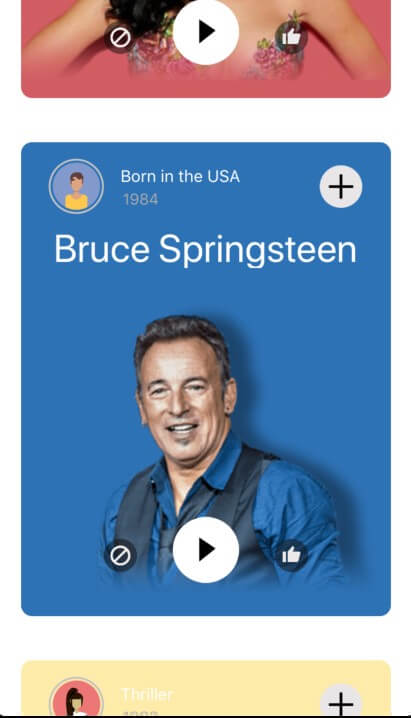
2. Cells 淡出 + TableView Cell 縮小
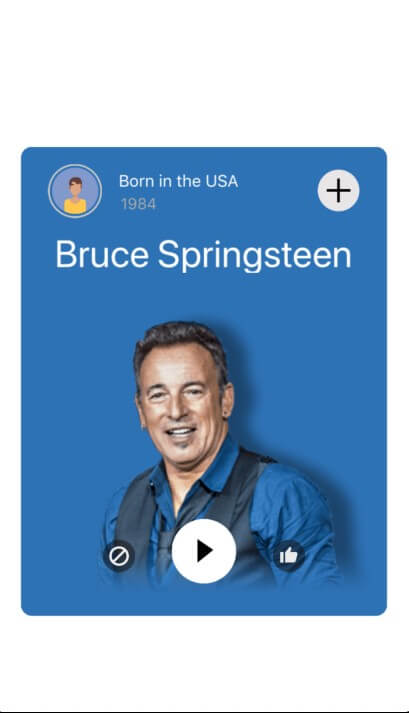
3. Avatar 和 Plus ImageView 利用一個 QuadCurve Animation 執行動畫。其他物件則執行線性動畫 (Linear Animation).
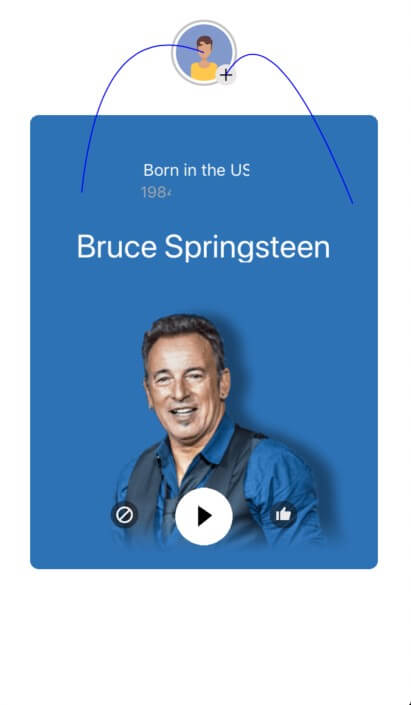
4. 最終動畫:Background 擴展至與容器視圖同寬,高度為螢幕的一半,而帶有標籤的 Avatar 和 Plus Image 也會同時擴展。
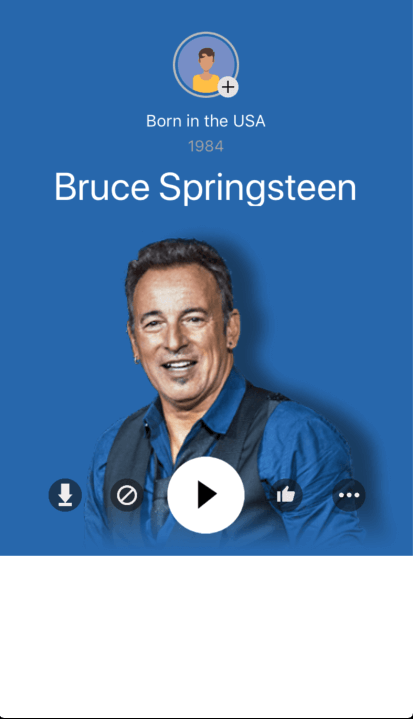
讓我們進入動畫控制器!
在這邊,我們將提供 2 個客製化的轉場動畫:一個用來 push,一個用在 pop。現在讓我們專注在 push 動畫,首先,我們需要準備什麼?
一個動畫控制器 (Animation Controller) !
該控制器需要實作下列兩種方法,以符合 UIViewControllerAnimatedTransitioning() 協定。
1. transitionDuration:整個動畫的持續時間
transitionDuration(using transitionContext: UIViewControllerContextTransitioning?) -> TimeInterval2. animateTransition(using:): 這是動畫邏輯所在
animateTransition(using transitionContext: UIViewControllerContextTransitioning)讓我們開始第一個動畫吧。
- PushAnimator:
class PushAnimator: NSObject, UIViewControllerAnimatedTransitioning {
func transitionDuration(using transitionContext: UIViewControllerContextTransitioning?) -> TimeInterval {
return 2.0
}
func animateTransition(using transitionContext: UIViewControllerContextTransitioning) {
}
}在轉場期間,我們需要提供一個容器視圖 (container view),讓轉場動畫在裡面運行。
- 以下是需要添加到控制器視圖的 transitionContext 視圖:
class PushAnimator: NSObject, UIViewControllerAnimatedTransitioning {
func transitionDuration(using transitionContext: UIViewControllerContextTransitioning?) -> TimeInterval {
return 2.0
}
func animateTransition(using transitionContext: UIViewControllerContextTransitioning) {
let containerView = transitionContext.containerView
guard let fromVC = transitionContext.viewController(forKey: .from) as? animTransitionable,
let toVC = transitionContext.viewController(forKey: .to) as? animTransitionable else {
transitionContext.completeTransition(false)
return
}
let fromViewController = transitionContext.viewController(forKey: .from)!
fromViewController.view.backgroundColor = UIColor.clear
let toViewController = transitionContext.viewController(forKey: .to)!
}
}我們將會新增一個協定,用來獲取要執行動畫的視圖單元格的參考。該協定可用於 MainViewController 和 PushedViewController。
protocol animTransitionable {
var profileImageView: UIImageView { get }
var backgroundImageView: UIImageView { get }
var plusImageView: UIImageView { get }
var playImageView: UIImageView { get }
var likeImageView: UIImageView { get }
var cancelImageView: UIImageView { get }
var backgroundColor: UIView { get }
var cellBackground: UIView { get }
var bigTitle: UILabel { get }
var albumLbl: UILabel { get }
var yearLbl: UILabel { get }
}所以 ⋯⋯ 我們要如何透過動畫使物件從一個視圖控制器移動到另一個呢?我們需要創建每個視圖/物件,將它們添加到容器視圖中,並設置動畫。
來看一下如何實作程式碼吧:
class PushAnimator: NSObject, UIViewControllerAnimatedTransitioning {
var duration : TimeInterval
init(duration : TimeInterval) {
self.duration = duration
}
func transitionDuration(using transitionContext: UIViewControllerContextTransitioning?) -> TimeInterval {
return duration
}
func animateTransition(using transitionContext: UIViewControllerContextTransitioning) {
let containerView = transitionContext.containerView
guard let fromVC = transitionContext.viewController(forKey: .from) as? animTransitionable,
let toVC = transitionContext.viewController(forKey: .to) as? animTransitionable else {
transitionContext.completeTransition(false)
return
}
let fromViewController = transitionContext.viewController(forKey: .from)!
let toViewController = transitionContext.viewController(forKey: .to)!
// Plus Image
let imageViewSnapshotPlus = UIImageView(image: fromVC.plusImageView.image)
imageViewSnapshotPlus.contentMode = .scaleAspectFit
//Profile Image
let imageViewSnapshotProfile = UIImageView(image: fromVC.profileImageView.image)
imageViewSnapshotProfile.contentMode = .scaleAspectFit
//Background Image
let imageViewSnapshotBackground = UIImageView(image: fromVC.backgroundImageView.image)
imageViewSnapshotBackground.contentMode = .scaleAspectFit
//Like Image
let imageViewSnapshotLike = UIImageView(image: fromVC.likeImageView.image)
imageViewSnapshotLike.contentMode = .scaleAspectFit
//Play Image
let imageViewSnapshotPlay = UIImageView(image: fromVC.playImageView.image)
imageViewSnapshotPlay.contentMode = .scaleAspectFit
//Cancel Image
let imageViewSnapshotCancel = UIImageView(image: fromVC.cancelImageView.image)
imageViewSnapshotCancel.contentMode = .scaleAspectFit
//Background View With Correct Color
let backgroundView = UIView()
backgroundView.frame = fromVC.backgroundColor.frame
backgroundView.backgroundColor = UIColor.white
containerView.addSubview(backgroundView)
// Title
let titleLabel = duplicateLabel(label: fromVC.bigTitle)
titleLabel.text = fromVC.bigTitle.text
titleLabel.backgroundColor = UIColor.clear
titleLabel.frame = containerView.convert(fromVC.bigTitle.frame, from: fromVC.bigTitle.superview)
// Album
let albumLabel = duplicateLabel(label: fromVC.albumLbl)
albumLabel.text = fromVC.albumLbl.text
albumLabel.backgroundColor = UIColor.clear
albumLabel.frame = containerView.convert(fromVC.albumLbl.frame, from: fromVC.albumLbl.superview)
// Year
let yearLabel = duplicateLabel(label: fromVC.yearLbl)
yearLabel.text = fromVC.yearLbl.text
yearLabel.backgroundColor = UIColor.clear
yearLabel.frame = containerView.convert(fromVC.yearLbl.frame, from: fromVC.yearLbl.superview)
// Cell Background
let cellBackground = UIView()
cellBackground.frame = containerView.convert(fromVC.cellBackground.frame, from: fromVC.cellBackground.superview)
cellBackground.backgroundColor = fromVC.cellBackground.backgroundColor
cellBackground.layer.cornerRadius = fromVC.cellBackground.layer.cornerRadius
cellBackground.layer.masksToBounds = fromVC.cellBackground.layer.masksToBounds
containerView.addSubview(fromViewController.view)
containerView.addSubview(toViewController.view)
// Background Cell
containerView.addSubview(cellBackground)
// Top
containerView.addSubview(imageViewSnapshotProfile)
containerView.addSubview(imageViewSnapshotBackground)
containerView.addSubview(imageViewSnapshotPlus)
// Down
containerView.addSubview(imageViewSnapshotPlay)
containerView.addSubview(imageViewSnapshotCancel)
containerView.addSubview(imageViewSnapshotLike)
// Title Label
containerView.addSubview(titleLabel)
containerView.addSubview(albumLabel)
containerView.addSubview(yearLabel)
containerView.bringSubview(toFront: imageViewSnapshotPlus)
}
}來到這一步,我們得到:
- ImageView
- Plus Image View
- Profile Image View(也就是 Avatar)
- Background
- Like(讚好鍵)
- Play(播放鍵)
- Cancel(取消鍵)
- View
- Background
- Label(標籤)
- Title(標題)
- Album(專輯)
- Year(年份)
PushAnimator 的完整動畫:
class PushAnimator: NSObject, UIViewControllerAnimatedTransitioning {
var duration : TimeInterval
init(duration : TimeInterval) {
self.duration = duration
}
func transitionDuration(using transitionContext: UIViewControllerContextTransitioning?) -> TimeInterval {
return duration
}
func animateTransition(using transitionContext: UIViewControllerContextTransitioning) {
let containerView = transitionContext.containerView
guard let fromVC = transitionContext.viewController(forKey: .from) as? animTransitionable,
let toVC = transitionContext.viewController(forKey: .to) as? animTransitionable else {
transitionContext.completeTransition(false)
return
}
let fromViewController = transitionContext.viewController(forKey: .from)!
let toViewController = transitionContext.viewController(forKey: .to)!
// Plus Image
let imageViewSnapshotPlus = UIImageView(image: fromVC.plusImageView.image)
imageViewSnapshotPlus.contentMode = .scaleAspectFit
//Profile Image
let imageViewSnapshotProfile = UIImageView(image: fromVC.profileImageView.image)
imageViewSnapshotProfile.contentMode = .scaleAspectFit
//Background Image
let imageViewSnapshotBackground = UIImageView(image: fromVC.backgroundImageView.image)
imageViewSnapshotBackground.contentMode = .scaleAspectFit
//Like Image
let imageViewSnapshotLike = UIImageView(image: fromVC.likeImageView.image)
imageViewSnapshotLike.contentMode = .scaleAspectFit
//Play Image
let imageViewSnapshotPlay = UIImageView(image: fromVC.playImageView.image)
imageViewSnapshotPlay.contentMode = .scaleAspectFit
//Cancel Image
let imageViewSnapshotCancel = UIImageView(image: fromVC.cancelImageView.image)
imageViewSnapshotCancel.contentMode = .scaleAspectFit
//Background View With Correct Color
let backgroundView = UIView()
backgroundView.frame = fromVC.backgroundColor.frame
backgroundView.backgroundColor = UIColor.white
containerView.addSubview(backgroundView)
// Title
let titleLabel = duplicateLabel(label: fromVC.bigTitle)
titleLabel.text = fromVC.bigTitle.text
titleLabel.backgroundColor = UIColor.clear
titleLabel.frame = containerView.convert(fromVC.bigTitle.frame, from: fromVC.bigTitle.superview)
// Album
let albumLabel = duplicateLabel(label: fromVC.albumLbl)
albumLabel.text = fromVC.albumLbl.text
albumLabel.backgroundColor = UIColor.clear
albumLabel.frame = containerView.convert(fromVC.albumLbl.frame, from: fromVC.albumLbl.superview)
// Year
let yearLabel = duplicateLabel(label: fromVC.yearLbl)
yearLabel.text = fromVC.yearLbl.text
yearLabel.backgroundColor = UIColor.clear
yearLabel.frame = containerView.convert(fromVC.yearLbl.frame, from: fromVC.yearLbl.superview)
// Cell Background
let cellBackground = UIView()
cellBackground.frame = containerView.convert(fromVC.cellBackground.frame, from: fromVC.cellBackground.superview)
cellBackground.backgroundColor = fromVC.cellBackground.backgroundColor
cellBackground.layer.cornerRadius = fromVC.cellBackground.layer.cornerRadius
cellBackground.layer.masksToBounds = fromVC.cellBackground.layer.masksToBounds
containerView.addSubview(fromViewController.view)
containerView.addSubview(toViewController.view)
// Background Cell
containerView.addSubview(cellBackground)
// Top
containerView.addSubview(imageViewSnapshotProfile)
containerView.addSubview(imageViewSnapshotBackground)
containerView.addSubview(imageViewSnapshotPlus)
// Down
containerView.addSubview(imageViewSnapshotPlay)
containerView.addSubview(imageViewSnapshotCancel)
containerView.addSubview(imageViewSnapshotLike)
// Title Label
containerView.addSubview(titleLabel)
containerView.addSubview(albumLabel)
containerView.addSubview(yearLabel)
containerView.bringSubview(toFront: imageViewSnapshotPlus)
fromViewController.view.isHidden = true
toViewController.view.isHidden = true
// TOP
imageViewSnapshotPlus.frame = containerView.convert(fromVC.plusImageView.frame, from: fromVC.plusImageView.superview)
imageViewSnapshotProfile.frame = containerView.convert(fromVC.profileImageView.frame, from: fromVC.profileImageView.superview)
imageViewSnapshotBackground.frame = containerView.convert(fromVC.backgroundImageView.frame, from: fromVC.backgroundImageView.superview)
// BOTTOM
imageViewSnapshotCancel.frame = containerView.convert(fromVC.cancelImageView.frame, from: fromVC.cancelImageView.superview)
imageViewSnapshotPlay.frame = containerView.convert(fromVC.playImageView.frame, from: fromVC.playImageView.superview)
imageViewSnapshotLike.frame = containerView.convert(fromVC.likeImageView.frame, from: fromVC.likeImageView.superview)
let frameBackground: CGRect = containerView.convert(toVC.backgroundColor.frame, from: toVC.backgroundColor.superview)
// TOP
let frameProfile: CGRect = containerView.convert(toVC.profileImageView.frame, from: toVC.profileImageView.superview)
let frameBackgroundImage: CGRect = containerView.convert(toVC.backgroundImageView.frame, from: toVC.backgroundImageView.superview)
let framePlus: CGRect = containerView.convert(toVC.plusImageView.frame, from: toVC.plusImageView.superview)
// BOTTOM
let framePlay: CGRect = containerView.convert(toVC.playImageView.frame, from: toVC.playImageView.superview)
// Animators
let animator1 = {
UIViewPropertyAnimator(duration: 0.5, dampingRatio: 0.8) {
let backgroundX = cellBackground.frame.minX + (cellBackground.frame.width * 5 / 100)
let backgroundWidth = cellBackground.frame.width - (cellBackground.frame.width * 10 / 100)
// BACKGROUND
cellBackground.frame = CGRect(x: backgroundX , y: cellBackground.frame.minY + (cellBackground.frame.minY * 5 / 100), width: backgroundWidth, height: cellBackground.frame.height - (cellBackground.frame.height * 10 / 100))
// LABEL
titleLabel.transform = CGAffineTransform(scaleX: 0.8, y: 0.8)
titleLabel.frame = CGRect(x: titleLabel.frame.minX , y: titleLabel.frame.minY + 15, width: titleLabel.frame.width, height: titleLabel.frame.height)
// TOP
imageViewSnapshotPlus.frame = CGRect(x: cellBackground.frame.maxX - (imageViewSnapshotPlus.frame.width * 20 / 100) - 40 , y: cellBackground.frame.minY + (imageViewSnapshotPlus.frame.height * 20 / 100) + 10, width: imageViewSnapshotPlus.frame.width - (imageViewSnapshotPlus.frame.width * 20 / 100), height: imageViewSnapshotPlus.frame.height - (imageViewSnapshotPlus.frame.height * 20 / 100))
imageViewSnapshotProfile.frame = CGRect(x: cellBackground.frame.minX - (imageViewSnapshotProfile.frame.width * 20 / 100) + 30 , y: cellBackground.frame.minY + (imageViewSnapshotProfile.frame.height * 20 / 100) + 10, width: imageViewSnapshotProfile.frame.width - (imageViewSnapshotProfile.frame.width * 20 / 100), height: imageViewSnapshotProfile.frame.height - (imageViewSnapshotProfile.frame.height * 20 / 100))
// LAbels
albumLabel.frame = CGRect(x: imageViewSnapshotProfile.frame.maxX + 15 , y: imageViewSnapshotProfile.frame.minY + 3, width: albumLabel.frame.width, height: albumLabel.frame.height)
albumLabel.sizeToFit()
yearLabel.frame = CGRect(x: imageViewSnapshotProfile.frame.maxX + 15 , y: imageViewSnapshotProfile.frame.minY + 23, width: yearLabel.frame.width, height: yearLabel.frame.height)
yearLabel.sizeToFit()
// Image Background
let widthBackground = (imageViewSnapshotBackground.frame.width - (imageViewSnapshotBackground.frame.width * 20 / 100) )
let heightBackground = (imageViewSnapshotBackground.frame.height - (imageViewSnapshotBackground.frame.height * 20 / 100) )
let midPostionPlayButton = imageViewSnapshotPlay.frame.width - (imageViewSnapshotPlay.frame.width * 20 / 100)
imageViewSnapshotBackground.frame = CGRect(x: cellBackground.frame.midX - (widthBackground / 2) , y: cellBackground.frame.maxY - (heightBackground) , width: widthBackground, height: imageViewSnapshotBackground.frame.height - (imageViewSnapshotBackground.frame.height * 20 / 100))
imageViewSnapshotPlay.frame = CGRect(x: cellBackground.frame.midX - (midPostionPlayButton / 2), y: cellBackground.frame.maxY - imageViewSnapshotPlay.frame.height - 10, width: imageViewSnapshotPlay.frame.width - (imageViewSnapshotPlay.frame.width * 20 / 100), height: imageViewSnapshotPlay.frame.width - (imageViewSnapshotPlay.frame.width * 20 / 100))
imageViewSnapshotCancel.frame = CGRect(x: cellBackground.frame.midX - (midPostionPlayButton / 2) - imageViewSnapshotCancel.frame.width - 30, y: cellBackground.frame.maxY - (imageViewSnapshotCancel.frame.height * 2), width: imageViewSnapshotCancel.frame.width - (imageViewSnapshotCancel.frame.width * 20 / 100), height: imageViewSnapshotCancel.frame.height - (imageViewSnapshotCancel.frame.height * 20 / 100))
imageViewSnapshotLike.frame = CGRect(x: cellBackground.frame.midX + (midPostionPlayButton / 2) + (imageViewSnapshotLike.frame.width * 20 / 100) + 30, y: cellBackground.frame.maxY - (imageViewSnapshotLike.frame.height * 2) , width: imageViewSnapshotLike.frame.width - (imageViewSnapshotLike.frame.width * 20 / 100), height: imageViewSnapshotLike.frame.height - (imageViewSnapshotLike.frame.height * 20 / 100))
}
}()
// Animators
let animator2 = {
//UIViewPropertyAnimator(duration: 0.5, dampingRatio: 0.6) {
UIViewPropertyAnimator(duration: 0.3, curve: .easeOut) {
cellBackground.frame = CGRect(x: frameBackground.minX , y: frameBackground.minY, width: UIScreen.main.bounds.width, height: frameBackground.height)
cellBackground.layer.cornerRadius = 0
// Label
titleLabel.transform = CGAffineTransform(scaleX: 1.0, y: 1.0)
titleLabel.frame = containerView.convert(toVC.bigTitle.frame, from: toVC.bigTitle.superview)
albumLabel.transform = CGAffineTransform(scaleX: 1.0, y: 1.0)
albumLabel.frame = containerView.convert(toVC.albumLbl.frame, from: toVC.albumLbl.superview)
albumLabel.textAlignment = .center
yearLabel.transform = CGAffineTransform(scaleX: 1.0, y: 1.0)
yearLabel.frame = containerView.convert(toVC.yearLbl.frame, from: toVC.yearLbl.superview)
yearLabel.textAlignment = .center
imageViewSnapshotCancel.frame = containerView.convert(toVC.cancelImageView.frame, from: toVC.cancelImageView.superview)
imageViewSnapshotPlay.frame = containerView.convert(toVC.playImageView.frame, from: toVC.playImageView.superview)
imageViewSnapshotLike.frame = containerView.convert(toVC.likeImageView.frame, from: toVC.likeImageView.superview)
imageViewSnapshotBackground.frame = containerView.convert(toVC.backgroundImageView.frame, from: toVC.backgroundImageView.superview)
cellBackground.layoutIfNeeded()
}
}()
animator1.addCompletion { _ in
animator2.startAnimation()
// Group Animator
doBezierAnimation(showLayerAnimation: false)
}
animator2.addCompletion { _ in
// Background
cellBackground.removeFromSuperview()
// Labels
titleLabel.removeFromSuperview()
albumLabel.removeFromSuperview()
yearLabel.removeFromSuperview()
// TOP
imageViewSnapshotProfile.removeFromSuperview()
imageViewSnapshotPlus.removeFromSuperview()
imageViewSnapshotBackground.removeFromSuperview()
// BOTTOM
imageViewSnapshotCancel.removeFromSuperview()
imageViewSnapshotPlay.removeFromSuperview()
imageViewSnapshotLike.removeFromSuperview()
fromViewController.view.removeFromSuperview()
toViewController.view.isHidden = false
transitionContext.completeTransition(!transitionContext.transitionWasCancelled)
}
animator1.startAnimation()
func doBezierAnimation(showLayerAnimation: Bool = false) {
// PROFILE IMAGE
// Profile Animation
var bezierPath = UIBezierPath()
bezierPath.move(to: CGPoint(x: imageViewSnapshotProfile.frame.midX, y: imageViewSnapshotProfile.frame.midY))
bezierPath.addQuadCurve(to: CGPoint(x: UIScreen.main.bounds.width / 2 , y: frameProfile.midY), controlPoint: CGPoint(x: frameProfile.midX/2, y: frameProfile.midY/2))
var shapeLayer = CAShapeLayer()
// The Bezier path that we made needs to be converted to a CGPath before it can be used on a layer.
shapeLayer.path = bezierPath.cgPath
shapeLayer.strokeColor = UIColor.blue.cgColor
shapeLayer.fillColor = UIColor.clear.cgColor
shapeLayer.lineWidth = 1.0
// Enable/Disable for debug
if showLayerAnimation {
containerView.layer.addSublayer(shapeLayer)
}
let profileAnimationPosition = CAKeyframeAnimation(keyPath: "position")
profileAnimationPosition.path = bezierPath.cgPath
// I set this one to make the animation go smoothly along the path
profileAnimationPosition.calculationMode = kCAAnimationPaced
profileAnimationPosition.duration = 0.3
profileAnimationPosition.timingFunction = CAMediaTimingFunction(name: kCAMediaTimingFunctionEaseOut)
let profileAnimationBounds = CAKeyframeAnimation(keyPath: "bounds")
profileAnimationBounds.duration = 0.3
profileAnimationBounds.values = [imageViewSnapshotProfile.frame, containerView.convert(toVC.profileImageView.frame, from: toVC.profileImageView.superview)]
profileAnimationBounds.timingFunction = CAMediaTimingFunction(name: kCAMediaTimingFunctionEaseOut)
profileAnimationBounds.beginTime = 0
// Let's group the animation for position and bounds into one
let groupProfile = CAAnimationGroup()
groupProfile.animations = [profileAnimationPosition, profileAnimationBounds]
groupProfile.duration = 0.3
groupProfile.repeatCount = 0
groupProfile.timingFunction = CAMediaTimingFunction(name: kCAMediaTimingFunctionEaseOut)
groupProfile.isRemovedOnCompletion = false
groupProfile.fillMode = kCAFillModeForwards
imageViewSnapshotProfile.layer.add(groupProfile, forKey: "profileAnimation")
//--- PLUS IMAGE ---//
// Plus ImageView Animation
bezierPath = UIBezierPath()
bezierPath.move(to: CGPoint(x: imageViewSnapshotPlus.frame.maxX, y: imageViewSnapshotPlus.frame.maxY))
bezierPath.addQuadCurve(to: CGPoint(x: (UIScreen.main.bounds.width / 2) + 20, y: framePlus.maxY - 10), controlPoint: CGPoint(x:framePlus.maxX + 30, y: framePlus.maxY/4))
shapeLayer = CAShapeLayer()
// The Bezier path that we made needs to be converted to
shapeLayer.path = bezierPath.cgPath
shapeLayer.strokeColor = UIColor.blue.cgColor
shapeLayer.fillColor = UIColor.clear.cgColor
shapeLayer.lineWidth = 1.0
// Enable/Disable for debug
if showLayerAnimation {
containerView.layer.addSublayer(shapeLayer)
}
let plusAnimationPosition = CAKeyframeAnimation(keyPath: "position")
plusAnimationPosition.path = bezierPath.cgPath
// I set this one to make the animation go smoothly along the path
plusAnimationPosition.calculationMode = kCAAnimationPaced
plusAnimationPosition.duration = 0.3
plusAnimationPosition.rotationMode = kCAAnimationLinear
plusAnimationPosition.timingFunction = CAMediaTimingFunction(name: kCAMediaTimingFunctionEaseOut)
let plusAnimationBounds = CAKeyframeAnimation(keyPath: "bounds")
plusAnimationBounds.duration = 0.3
plusAnimationBounds.values = [imageViewSnapshotPlus.frame, containerView.convert(toVC.plusImageView.frame, from: toVC.plusImageView.superview)]
plusAnimationBounds.timingFunction = CAMediaTimingFunction(name: kCAMediaTimingFunctionEaseOut)
plusAnimationBounds.beginTime = 0
// Let's group the animation for position and bounds into one
let groupPlus = CAAnimationGroup()
groupPlus.animations = [plusAnimationPosition, plusAnimationBounds]
groupPlus.duration = 0.3
groupPlus.repeatCount = 0
groupPlus.timingFunction = CAMediaTimingFunction(name: kCAMediaTimingFunctionEaseOut)
groupPlus.isRemovedOnCompletion = false
groupPlus.fillMode = kCAFillModeForwards
imageViewSnapshotPlus.layer.add(groupPlus, forKey: "doit")
}
}
}
以下是動畫的簡要說明:
Animator 1:製作單元格與標題縮小的動畫。
Animator 2:我們對頂部進行動畫處理,將單元格擴展到主視圖的寬度,並對標籤和 Cancel、Like、Play ImageView 進行動畫處理。
doBezierAnimation:Avatar 和 Plus ImageView 的 Bezier 和 QuadCurve 動畫。
而 Pop animator 的製作方法是一樣的,只是順序相反。我們只需要對 QuadCurve 作出改動,讓動畫更加流暢。因為程式碼幾乎一樣,所以我們不會深入探討。
來到這一步,我們已經製作好所需的一切了,只需要在兩個視圖控制器之間添加 TransitionCoordinator。
請在 MainViewController 添加以下程式碼:
let transition = TransitionCoordinator()
當單元格被點擊後,我們會將這個 transition 物件添加到 NavigationController delegate 中,執行「淡出」動畫,並將 ViewController 推到 PushedViewController。
func tableView(_ tableView: UITableView, didSelectRowAt indexPath: IndexPath) {
self.selectedIndexPath = indexPath
doAnimFadeOut()
let finalVC = PushedViewController()
finalVC.selectedProfileImage = dictionaryDataArray[indexPath.section]["profileImage"]!
finalVC.selectedBackgroundImage = dictionaryDataArray[indexPath.section]["backgroundImage"]!
finalVC.mainTitle = dictionaryDataArray[indexPath.section]["title"]!
finalVC.album = dictionaryDataArray[indexPath.section]["album"]!
finalVC.year = dictionaryDataArray[indexPath.section]["year"]!
finalVC.topHexColor = dictionaryDataArray[indexPath.section]["hexBackgroundColor"]!
navigationController?.delegate = transition
DispatchQueue.main.asyncAfter(deadline: .now() + (Double(self.tableView.visibleCells.count) * 0.15 )) { // change 2 to desired number of seconds
self.navigationController?.pushViewController(finalVC, animated: true)
}
}讓我們看一下 TransitionCoordinator 的程式碼:
// NavigationController Delegate for Transition Coordinator
class TransitionCoordinator: NSObject, UINavigationControllerDelegate {
func navigationController(_ navigationController: UINavigationController,
animationControllerFor operation: UINavigationControllerOperation,
from fromVC: UIViewController,
to toVC: UIViewController) -> UIViewControllerAnimatedTransitioning? {
switch operation {
case .push:
return PushAnimator()
case .pop:
return PopAnimator()
default:
return nil
}
}
}此類別設置 NavigationController delegate,並檢查我們正在執行哪種類型的操作:如果正在執行 push,它就會回傳一個 PushAnimator() 物件;而如果是 pop,它就會回傳一個 PopAnimator() 物件。
總結
這個轉場效果剛開始接觸可能有點困難,但請相信我,這實作起來很簡單! 希望你喜歡這篇文章!
如果你有任何評論、問題或建議,請隨時在下面留言!
你可以在這裡下載 Github 原始碼。


